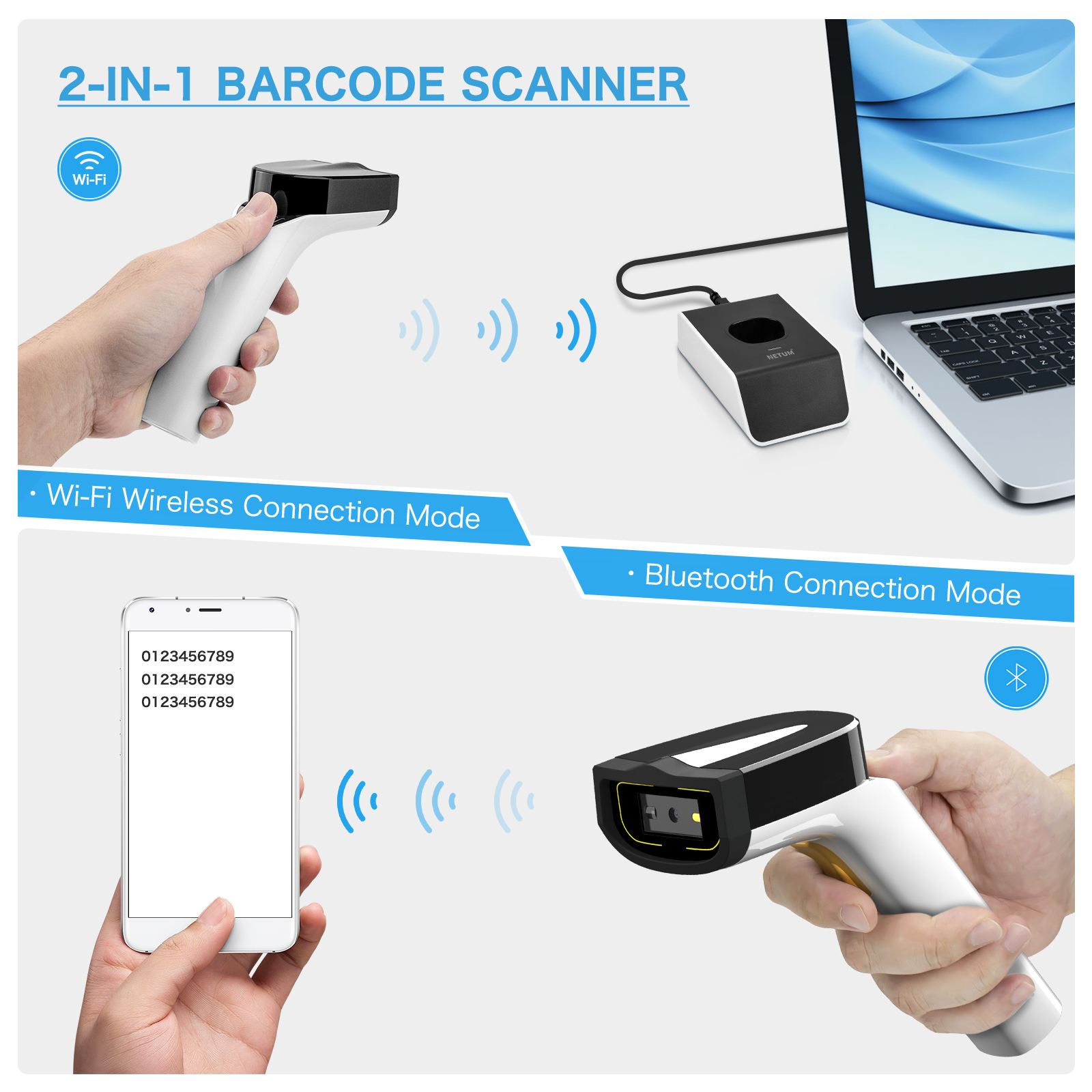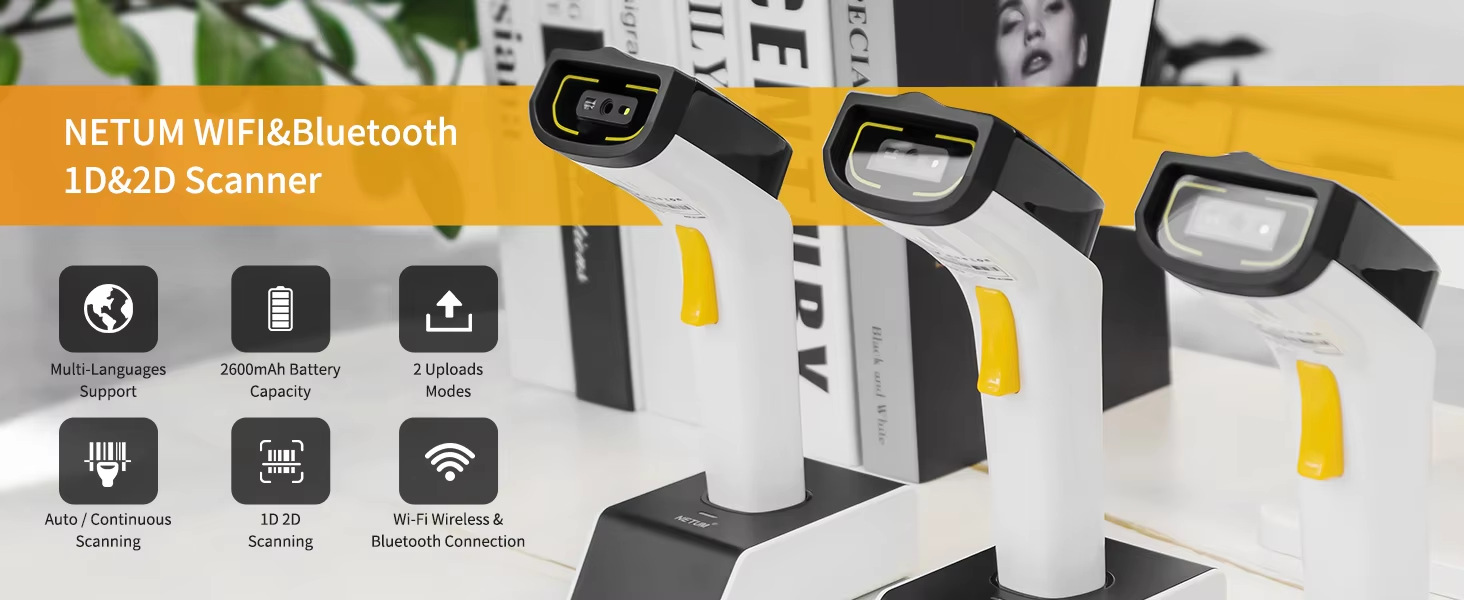In the fast-paced world of retail, logistics, and manufacturing, efficiency and flexibility are key to staying competitive. Barcode scanners have long been essential tools for streamlining operations, but the shift from traditional wired models to modern solutions like the WiFi barcode scanner and wireless WiFi barcode scanner has revolutionized how businesses handle data capture. Unlike traditional barcode scanners, which rely on cumbersome cables and limited functionality, WiFi-enabled options—especially advanced 2D barcode scanner variants—offer unique benefits that address the evolving needs of today’s workplaces. Below, we break down these advantages and explain why WiFi barcode scanners are becoming the go-to choice for forward-thinking businesses.

1. Unrestricted Mobility: Break Free from Cable Limitations
Traditional barcode scanners are chained to workstations by cables, confining users to a small, fixed area. This restriction becomes a major bottleneck in large spaces like warehouses, supermarkets, or manufacturing floors, where staff often need to scan items on high shelves, moving carts, or distant storage zones. Dragging cables across these areas not only slows down work but also increases the risk of tripping hazards or cable damage, leading to costly downtime.
The WiFi barcode scanner eliminates this problem entirely. As a true wireless WiFi barcode scanner, it connects to your network without physical wires, letting staff move freely within WiFi coverage (often up to 300 feet in unobstructed environments). For example, in a logistics warehouse, a worker can carry a WiFi barcode scanner to scan incoming shipments at the loading dock, then walk to the inventory zone to update stock—all without returning to a fixed terminal. Even advanced models like the 2D barcode scanner retain this mobility, allowing users to capture 2D codes (such as QR codes) on labels, packages, or digital screens from any angle. This flexibility cuts down on unnecessary movement and speeds up tasks like inventory checks or order picking by 40% or more.
2. Real-Time Data Sync: Keep Systems Updated Instantly
Traditional barcode scanners often store data locally first, requiring manual transfers to a computer or server at the end of a shift. This “offline” approach creates delays: if a store clerk uses a traditional scanner to process sales, inventory levels in the backend system won’t update until the data is uploaded, leading to risks like overstocking or stockouts. In logistics, delayed data can mean customers wait hours to track their packages—frustrating both staff and clients.
The WiFi barcode scanner solves this with real-time data transmission. Every time you scan a barcode (whether 1D or 2D with a 2D barcode scanner), the data is sent immediately to your backend system (such as ERP or WMS software) via WiFi. For instance, a retail cashier using a wireless WiFi barcode scanner can scan a product, and the POS system and inventory database will update instantly—ensuring accurate stock counts and preventing overselling. In manufacturing, a WiFi barcode scanner can track components on the production line in real time, letting managers spot bottlenecks early. This instant sync eliminates data lags and keeps all teams working with the most up-to-date information.
3. Versatile Compatibility: Work with Any Barcode and Device
Traditional barcode scanners are often limited: many only read 1D barcodes (like UPC codes) and only connect to specific operating systems (such as older Windows versions). This becomes a problem as businesses adopt 2D barcodes—used for storing more data, like product details or batch numbers—or switch to mobile devices (like Android tablets) for on-the-go work. A traditional scanner that can’t read 2D codes or connect to a tablet becomes obsolete quickly.
The WiFi barcode scanner (including most 2D barcode scanner models) offers far greater compatibility. First, it supports both 1D and 2D barcodes: whether you’re scanning a standard UPC on a cereal box or a QR code on a logistics waybill, a 2D barcode scanner can capture it accurately. Second, WiFi barcode scanner devices work with multiple operating systems—Windows, Android, iOS—so you can connect them to computers, tablets, or even smartphones. For example, a small business owner can use a wireless WiFi barcode scanner with an iPad to process checkout and manage inventory, without buying expensive dedicated hardware. This versatility means the scanner can adapt to your existing tools, saving you from costly overhauls.
4. Durability for Harsh Environments: Stay Reliable When It Matters
Traditional barcode scanners are often designed for indoor, low-impact use. In harsh environments—like dusty warehouses, wet fresh food sections, or busy logistics hubs—they easily break down: dust clogs their sensors, water damages internal parts, and drops from carts can render them useless. Repairs or replacements add up, disrupting operations and increasing costs.
Many WiFi barcode scanner models (especially industrial-grade 2D barcode scanner options) are built to withstand tough conditions. They meet IP65 or IP67 standards, meaning they’re dustproof and waterproof—safe to use in rain, near cleaning sprays, or in dusty storage areas. They also have shock-resistant shells (made from materials like ABS plastic) that can handle drops from 1.5 to 2 meters. For example, a wireless WiFi barcode scanner used in a cold chain warehouse (-20°C) will keep working reliably, while a traditional scanner might freeze up. This durability reduces downtime and repair costs, making the WiFi barcode scanner a more reliable long-term investment.
5. Lower Long-Term Costs: Save Money Beyond the Initial Purchase
At first glance, traditional barcode scanners may seem cheaper than WiFi barcode scanner models. But when you factor in long-term costs, the tables turn. Traditional scanners require regular cable replacements (worn cables break often) and expensive wiring upgrades if you expand your workspace (like adding a new warehouse section). They also need more labor: a task like inventory that takes 2 people a full day with traditional scanners could take 1 person just 2 hours with a WiFi barcode scanner.
The WiFi barcode scanner cuts these costs significantly. As a wireless WiFi barcode scanner, it has no cables to replace or repair. Its real-time data sync and mobility reduce labor hours, lowering payroll expenses. And when you expand, you don’t need to rewire—just extend your WiFi network to cover new areas. Even advanced 2D barcode scanner models offer this cost efficiency: their ability to read multiple barcode types means you won’t need to buy separate scanners for 1D and 2D codes. Over time, these savings far outweigh the slightly higher initial cost of a WiFi barcode scanner.
In short, the WiFi barcode scanner—from basic wireless models to advanced 2D barcode scanner variants—outperforms traditional scanners in mobility, real-time data, compatibility, durability, and cost. For businesses looking to streamline operations and adapt to modern workflows, switching to a wireless WiFi barcode scanner isn’t just an upgrade—it’s a strategic choice that drives efficiency and growth.
If you need to compare specific models of WiFi barcode scanner or 2D barcode scanner for your business (like retail or logistics), I can help you create a model comparison table that highlights key features like range, durability, and price. Would you find this useful?


